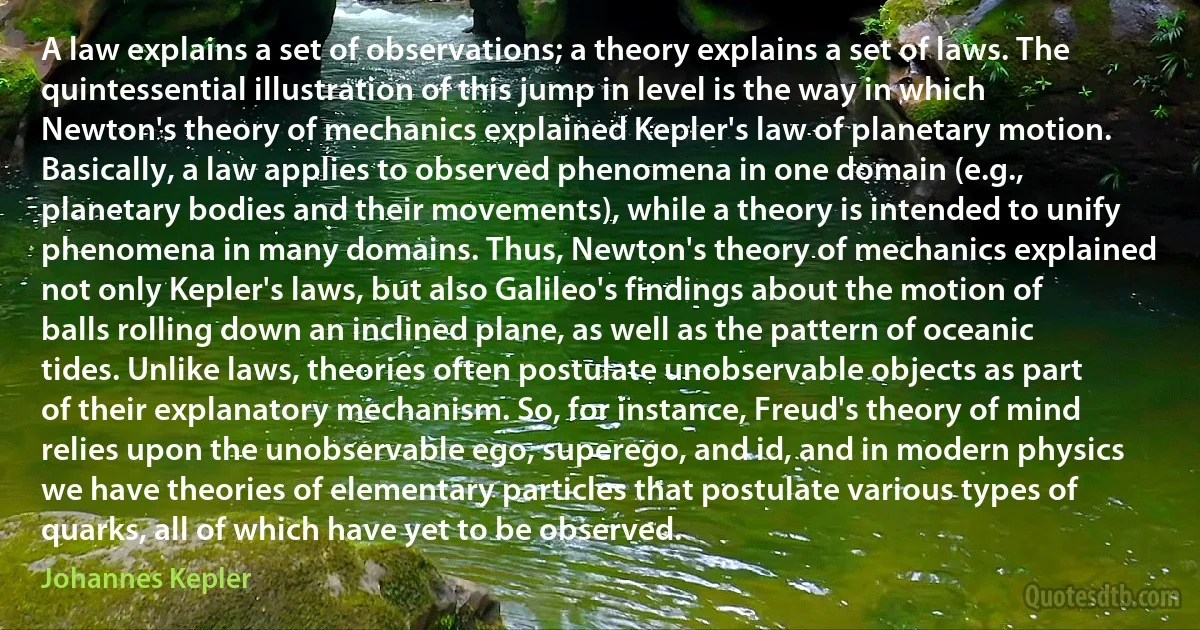
A law explains a set of observations; a theory explains a set of laws. The quintessential illustration of this jump in level is the way in which Newton's theory of mechanics explained Kepler's law of planetary motion. Basically, a law applies to observed phenomena in one domain (e.g., planetary bodies and their movements), while a theory is intended to unify phenomena in many domains. Thus, Newton's theory of mechanics explained not only Kepler's laws, but also Galileo's findings about the motion of balls rolling down an inclined plane, as well as the pattern of oceanic tides. Unlike laws, theories often postulate unobservable objects as part of their explanatory mechanism. So, for instance, Freud's theory of mind relies upon the unobservable ego, superego, and id, and in modern physics we have theories of elementary particles that postulate various types of quarks, all of which have yet to be observed.
Johannes KeplerRelated topics
elementary illustration instance jump law mechanics mechanism mind oceanic plane planetary postulate quintessential rolling set thus way well while yet lawsRelated quotes
First of all I want to remind you of the essential features of models. In my opinion they are: (i) drawing up a list of the variables to be considered; (ii) drawing up a list of the equations or relations the variables have to obey and (iii) testing the validity of the equations, which implies the estimation of their coefficients, if any. As a consequence of especially (iii) we may have to revise (i) and (ii) so as to arrive at a satisfactory degree of realism of the theory embodied in the model. Then, the model may be used for various purposes, that is, for the solution of various problems. The advantages of models are, on one hand, that they force us to present a "complete" theory by which I mean a theory taking into account all relevant phenomena and relations and, on the other hand, the confrontation with observation, that is, reality. Of course these remarks are far from new.

Jan Tinbergen
The misconception that costs determined prices prevented economists for a long time from recognizing that it was prices which operated as the indispensable signals telling producers what costs it was worth expending on the production of the various commodities and services, and not the other way around. It was the costs which they had expended which determined the prices of things produced.It was this crucial insight which finally broke through and established itself about a hundred years ago through the so-called marginal revolution in economics.The chief insight gained by modern economists is that the market is essentially an ordering mechanism, growing up without anybody wholly understanding it, that enables us to utilize widely dispersed information about the significance of circumstances of which we are mostly ignorant. However, the various planners (and not only the planners in the socialist camp) and dirigists have still not yet grasped this.

Friedrich Hayek
I hope none who hear me will confound this expression of mine with advocacy of the right of a state to remain in the Union, and to disregard its constitutional obligations by the nullification of the law. Such is not my theory. Nullification and secession, so often confounded, are indeed antagonistic principles. Nullification is a remedy which it is sought to apply within the Union, and against the agent of states. It is only to be justified when the agent has violated his constitutional obligation, and a state, assuming to judge for itself, denies the right of the agent thus to act, and appeals to the other states of the Union for a decision; but when the states themselves, and when the people of the states, have so acted as to convince us that they will not regard our constitutional rights, then, and then for the first time, arises the doctrine of secession in its practical application.

Jefferson Davis
In a theory in which parameters are added to quantum mechanics to determine the results of individual measurements, without changing the statistical predictions, there must be a mechanism whereby the setting of one measuring device can influence the reading of another instrument, however remote. Moreover, the signal involved must propagate instantaneously, so that such a theory could not be Lorentz invariant. Of course, the situation is different if the quantum mechanical predictions are of limited validity. Conceivably they might apply only to experiments in which the settings of the instruments are made sufficiently in advance to allow them to reach some mutual rapport by exchange of signals with velocity less than or equal to that of light. In that connection, experiments of the type proposed by Bohm and Aharonov, in which the settings are changed during the flight of the particles, are crucial.

John Stewart Bell
In a capitalist democracy there are essentially two methods by which social choices can be made: voting, typically used to make ‘political' decisions, and the market mechanism, typically used to make ‘economic' decisions. In the emerging democracies with mixed economic systems Great Britain, France, and Scandinavia, the same two modes of making social choices prevail, though more scope is given to the method of voting and to decisions based directly or indirectly on it and less to the rule of the price mechanism. Elsewhere in the world, and even in smaller social units within the democracies, the social decisions are sometimes made by single individuals or small groups and sometimes (more and more rarely in this modern world) by a widely encompassing set of traditional rules for making the social choice in any given situation, for example, a religious code.

Kenneth Arrow
